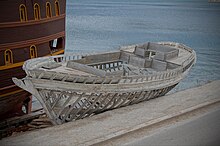Frame (nautical): Difference between revisions
m →Further reading: Task 3: Fix CS1 deprecated coauthor parameter errors |
add some details |
||
| Line 2: | Line 2: | ||
[[File:Ship Frames; Omiš, 2012-02-20 (1).jpg|thumb|Ship frames visible in an old wooden ship skeleton; [[Omiš]], Feb 20, 2012]] |
[[File:Ship Frames; Omiš, 2012-02-20 (1).jpg|thumb|Ship frames visible in an old wooden ship skeleton; [[Omiš]], Feb 20, 2012]] |
||
In [[ship|ships]], '''frames''' are ribs that are transverse bolted or welded to the [[keel]]. Frames support the [[hull (ship)|hull]] and give the ship its shape and strength |
In [[ship|ships]], '''frames''' are ribs that are transverse bolted or welded to the [[keel]]. Frames support the [[hull (ship)|hull]] and give the ship its shape and strength. |
||
In wooden shipbuilding, each frame is composed of several sections, so that the grain of the wood can follow the curve of the frame. Starting from the keel, these are the '''floor''' (which crosses the keel and joins the frame to the keel), the '''first futtock''', the '''second futtock''', the '''top timber''', and the '''rail stanchion'''.<ref>{{cite book |last=Crothers |first=William L |title=The American-built Clipper Ship |date=1997 |publisher=International Marine |isbn=0-07-014501-6 |page=142}}</ref> In steel shipbuilding, the entire frame can be formed in one piece by rivetting or welding sections; in this case the floor remains a separate piece, joining the frame on each side to the keel. |
|||
'''Frame numbers''' are the numerical values given to the frames; they begin at 1 with the first bow frame, and numbers increase sequentially to the last stern frame. The total number vary per the length of a ship.<ref>{{cite book |last=Cutler |first=Thomas J |title=The Bluejackets' Manual |date=2002 |publisher=United States Naval Institute |isbn=1-55750-221-8 |oclc=50226164 |page=237}}</ref> |
'''Frame numbers''' are the numerical values given to the frames; they begin at 1 with the first bow frame, and numbers increase sequentially to the last stern frame. The total number vary per the length of a ship.<ref>{{cite book |last=Cutler |first=Thomas J |title=The Bluejackets' Manual |date=2002 |publisher=United States Naval Institute |isbn=1-55750-221-8 |oclc=50226164 |page=237}}</ref> |
||
The frames support lengthwise members which run parallel to the keel, from the bow to the stern; these may variously be called '''stringers''', '''strakes''', or '''clamps'''. The clamp supports the transverse deck beams, on which the [[deck (ship)|deck]] is laid. |
|||
Frames may be supported by stringers, these stringers run perpendictular to the keel, from the bow to the stern. |
|||
Stringers can be used to support transverse deck beams, on which the [[deck (ship)|deck]] is laid |
|||
==References== |
==References== |
||
Revision as of 15:53, 20 August 2014


In ships, frames are ribs that are transverse bolted or welded to the keel. Frames support the hull and give the ship its shape and strength.
In wooden shipbuilding, each frame is composed of several sections, so that the grain of the wood can follow the curve of the frame. Starting from the keel, these are the floor (which crosses the keel and joins the frame to the keel), the first futtock, the second futtock, the top timber, and the rail stanchion.[1] In steel shipbuilding, the entire frame can be formed in one piece by rivetting or welding sections; in this case the floor remains a separate piece, joining the frame on each side to the keel.
Frame numbers are the numerical values given to the frames; they begin at 1 with the first bow frame, and numbers increase sequentially to the last stern frame. The total number vary per the length of a ship.[2]
The frames support lengthwise members which run parallel to the keel, from the bow to the stern; these may variously be called stringers, strakes, or clamps. The clamp supports the transverse deck beams, on which the deck is laid.
References
- ^ Crothers, William L (1997). The American-built Clipper Ship. International Marine. p. 142. ISBN 0-07-014501-6.
- ^ Cutler, Thomas J (2002). The Bluejackets' Manual. United States Naval Institute. p. 237. ISBN 1-55750-221-8. OCLC 50226164.
Further reading
- Turpin, Edward A.; McEwen, William A. (1980). Merchant Marine Officers' Handbook (4th ed.). Centreville, MD: Cornell Maritime Press. ISBN 0-87033-056-X.
{{cite book}}: Cite has empty unknown parameters:|origmonth=,|chapterurl=, and|origdate=(help)
